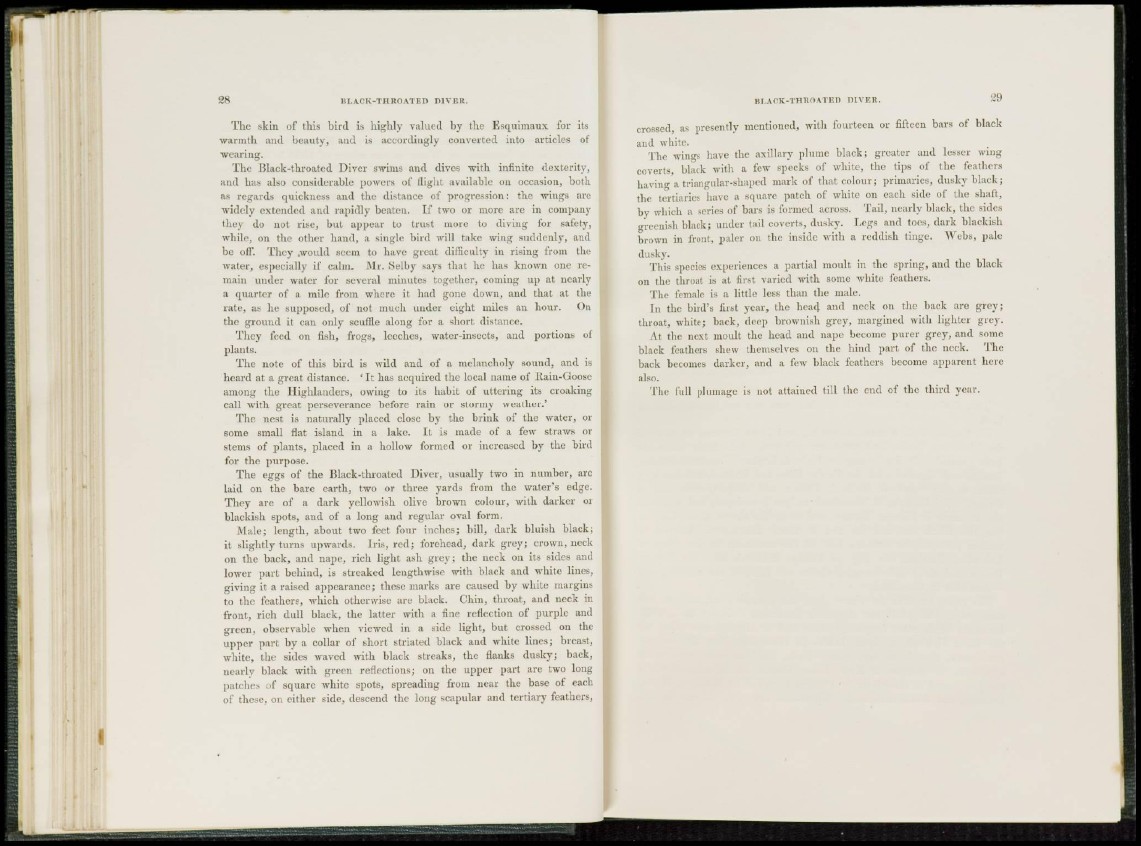
The skin of this bird is highly valued by the Esquimaux for its
warmth and beauty, and is accordingly converted into articles of
wearing.
The Black-throated Diver swims and dives with infinite dexterity,
and has also considerable powers of flight available on occasion, both
as regards quickness and the distance of progression: the wings are
widely e x t e n d e d and rapidly beaten. If two or more are in company
t h e y do not rise, but appear to trust more to diving for safety,
while, on the other hand, a single bird will take wing suddenly, and
be off. They .would seem to have great difficulty in rising from the
w a t e r , especially if calm. Mr. Selby says that he has known one remain
under water for several minutes together, coming up at nearly
a quarter of a mile from where it had gone down, and that at the
r a t e , as he suprjosed, of not much under eight miles an hour. On
t h e g r o u n d it can only scuffle along for a short distance.
T h e y feed on fish, frogs, leeches, water-insects, and portions of
plants.
The note of this bird is wild and of a melancholy sound, and is
h e a r d at a g r e a t distance. ' I t has a c q u i r e d t h e local name of ltain-Goose
among the H i g h l a n d e r s , owing to its habit of u t t e r i n g its croaking
call with great perseverance before rain or stormy weather.'
The nest is n a t u r a l l y placed close by the brink of the water, or
some small fiat island in a lake. It is made of a few straws or
stems of p l a n t s , placed in a hollow formed or increased by the bird
for the purpose.
The eggs of the Black-throated Diver, usually two in number, are
l a id on the bare earth, two or three yards from the water's edge.
T h e y are of a dark yellowish olive brown colour, with darker or
blackish spots, and of a long and regular oval form.
M a l e ; length, about two feet four inches; bill, dark bluish black;
it slightly t u r n s upwards. Iris, r e d ; forehead, dark grey; crown, neck
on the back, and nape, rich light ash grey; the neck on its sides and
lower part behind, is streaked lengthwise with black and white lines,
g i v i n g it a raised appearance; these marks are caused by white margins
t o the feathers, which otherwise arc black. Chin, throat, and neck in
front, rich dull black, the latter with a fine reflection of purple and
g r e e n , observable when viewed in a side light, but crossed on the
u p p e r part by a collar of short striated black and white l i n e s ; breast,
w h i t e , the sides waved with black streaks, the flanks dusky; back,
n e a r l y black with green reflections; on the upper part are two long
pa tehe> of square white spots, spreading from near the base of each
of these, ou either side, descend the long scapular and t e r t i a r y feathers,
crossed, as presently mentioned, with fourteen or fifteen bars of black
and white.
The wings have the axillary plume black; greater and lesser wing
coverts, black with a few specks of white, the tips of the feathers
having a triangular-shaped mark of that colour; primaries, dusky black;
t h e tertiaries have a square patch of white on each side of the shaft,
by which a series of bars is formed across. Tail, n e a r l y black, the sides
greenish black; under tail coverts, d u s k y . Legs and toes, d a r k blackish
brown in front, paler on the inside with a reddish tinge. Webs, pale
dusky.
This species experiences a partial moult in the spring, and the black
on the throat is at first varied with some white feathers.
The female is a l i t t l e less than the male.
In the bird's first year, the heacj and neck on the back are grey;
throat, white; back, deep brownish g r e y , margined with lighter grey.
At the next moult the head and nape become p u r e r grey, a n d some
black leathers shew themselves on the hind part of the neck. The
back becomes darker, and a few black feathers become apparent here
also.
The full plumage is not attained till the end of t h e t h i r d year.